| January
4, 2007
Presenting: Gene Domagala – A Human
Convenience Store of Charity and Community Involvement in Toronto's
Beach
One of the lessons travel has taught me is to not only get to know
the beauty of the foreign places, but to appreciate the uniqueness
of home. The more I travel, the more I have fallen in love with
my chosen home town, Toronto,
a city that offers a myriad of possibilities for travelers and residents
alike.
In this spirit I have embarked on a path towards a series of articles
and photo exhibitions to explore and celebrate
my chosen home town. A batch of recent visitors from Europe
has confirmed to me that Toronto is a great city, as each one of
my visitors have ended up falling in love with this city, intending
to come back and to get to know the Big Smoke better.
One of my visitors’ and my own personal favourites is Toronto’s
Beaches neighbourhood, or, as most local residents call it “The
Beach”. It is a beautiful neighbourhood, located – you
guessed it – right on the shores of Lake Ontario, and it has
the feel of an ocean-front resort community combined with the ambience
of a small town from yesteryear, with its dozens of individually
owned stores, galleries and restaurants.
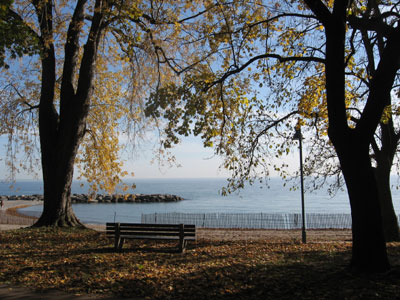
The Beach - an urban oasis in Toronto
But what makes any neighbourhood special is not just its physical
characteristics, its buildings and its architecture – it’s
the people that make the difference. Every community has its key
personalities, its human pillars, and my mission has been to search
out the individuals that stand out through their commitment to the
community. Often these are the unsung heroes who dedicate so much
of their personal time to help others while shunning the limelight.
My quest for community heroes began with a meeting with local representatives
and experts on the Beaches, which included Deborah Etsten from the
Beach Business Improvement Association,
and Michael Prue, the Provincial
Member of Parliament representing the Beaches/East York neighbourhoods.
Both of these experts pointed to Gene Domagala as one of the key
people in the Beach community.
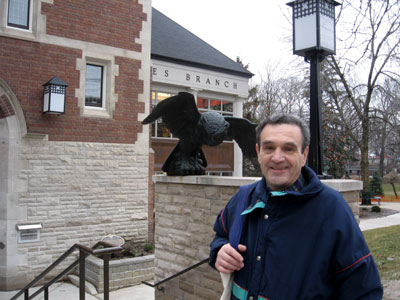
Gene Domagala in front of the Beaches Library
On one of the first really wintery days in Toronto, just a few
days before New Years, I met Gene at a real local landmark: the
Toronto Beaches Library. We met
near the checkout counter where Gene introduced me to Barbara Weissman,
the head librarian, who would later help me with some of my research
by compiling relevant materials about the Beach.
Gene’s charitable spirit immediately became obvious as we
stepped out of the library when he promised to get a cup of coffee
for a local homeless man in a wheelchair who had set himself up
just outside the library. Gene regularly helps out in local drop-in
centres who open their doors to the homeless on different days of
the week.
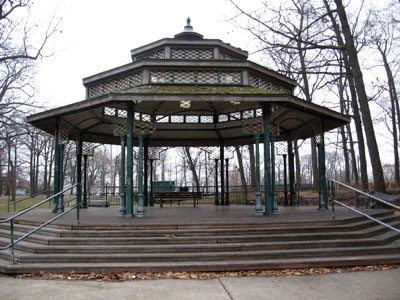
The treasured Kew Gardens bandstand
After dropping off the coffee Gene introduced me to one of Toronto’s
most beloved outdoor spaces: Kew Gardens, originally created by
one of the first settlers in this area. Joseph Williams and his
wife Jane bought a four acre property in 1853 to turn it into farmland.
Joseph, originally from London, England, always had fond memories
of Kew Gardens, the Royal Botanical Gardens in London, and in this
spirit he named his property “Kew Farms”. In 1879 he
opened a twenty acre pleasure ground, suitable for camping and picknicking
which he named “The Canadian Kew Gardens”. Gene explained
that as a teetotaler, Joseph Williams would serve meals and refreshments,
but definitely no alcoholic beverages.
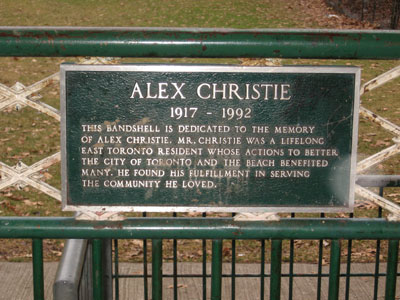
A tribute to Alex Christie
A well-used bandstand anchors the park and Gene pointed out a dedication
to a lifelong resident of East Toronto, Alex Christie (1917 –
1992) whose actions improving the community received permanent appreciation
in the plaque adorning the bandstand.
A few steps eastwards is the Dr. William D. Young Memorial, a Renaissance
style drinking fountain which was erected in 1920 to commemorate
a local doctor who had dedicated himself to public service, and
in particular, to the wellbeing of children in the area. Gene pointed
out that when Dr. Young passed away in 1919, he was almost penniless.
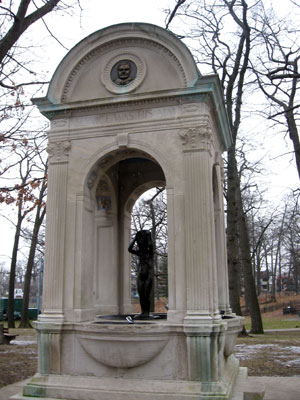
"Service was his aim": Dr. William D. Young
We strolled south on Lee Avenue, the main north-south artery in
the Beach, and Gene pointed out a former hotel with 13 rooms, today
a private residence. For well over a hundred years, the Beach has
been a popular recreation area, and from the late 1800s onwards,
people used to come from downtown Toronto in steamers to enjoy the
serenity and outdoor opportunities offered by the Beach.
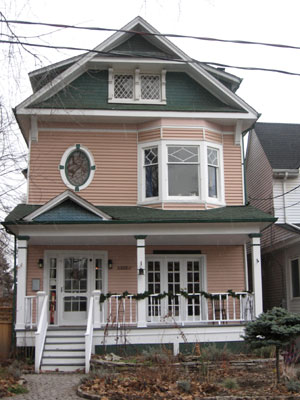
A former 31 room hotel, now a beautiful residence
By the late 1800s the Williams family had subdivided their plot
and built an entire subdivision of homes in parts of today’s
Kew Gardens. Joseph and Jane Williams’ son, Kew Williams,
had built a house adjoining Lee Avenue for his own family. According
to Gene, the grey stone was brought in by barge from Kingston, Ontario.
To the Williams family’s dismay, the City of Toronto expropriated
their property in 1907 to create a large park.
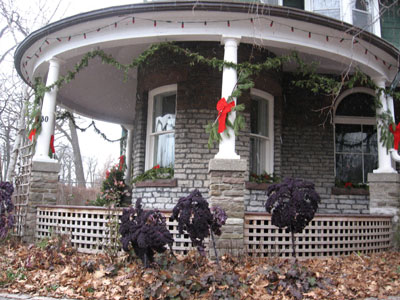
The Kew Williams House, also known as the "Gardener's Cottage"
All of the residences built in the park were demolished with the
exception of the Kew Williams House, which today is also referred
to as the Gardener’s cottage, the only residential building
west of Lee Avenue still standing in Kew Gardens. Gene mentioned
that one of Kew Williams’ daughters never set foot inside
of the house until about 12 years ago, in memory of the traumatic
experience that her family had gone through.
From the foot of Lee Avenue we went southwards where Gene pointed
out that years ago, the waterfront at the beach was composed of
a sandy barrier island with a stretch of water flowing just inland.
This inland river was later filled in. More than 100 years ago,
the waterfront would have been full of cottages and houses. Today
this area is a large public park with a wide sandy beach. Gene’s
extensive history knowledge (he has written more than 300 articles
for the local Beach Metro
Community News) touched on the Kew Beach Club which existed
here from 1903 and was demolished around 1930. The activities at
the club included bowling, tennis and water sports. Numerous photos
of the era show hundreds of canoes in the water and thousands of
people partaking of various water sports. Three major amusement
parks also adorned the Beaches at different times, all of which
were demolished long ago. Landowners more than 120 years ago recognized
the potential of this waterfront area for entertainment.
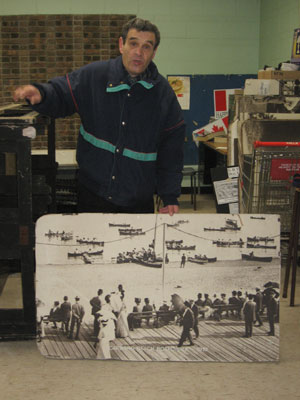
Gene with a historic photo of the action along the boardwalk
Throughout its history, the Beach has also been a centre of physical
recreation. Even today there are facilities for lawn bowling, tennis,
a big public swimming pool, a boathouse for canoes, hundreds of
permanently anchored wooden posts for beach volleyball, the boardwalk
and the Martin Goodman all-purpose recreational trail which are
widely used by joggers, cyclists and rollerbladers. For about a
century now, the Balmy Beach Club
has been a recreational institution at the east end of the neighbourhood.
Kite-flying on blustery spring and fall days is also a popular practice
along the long sandy beach. Dog lovers flock to this area as well
due to its extensive off-leash areas where they can let their furry
friends run free.
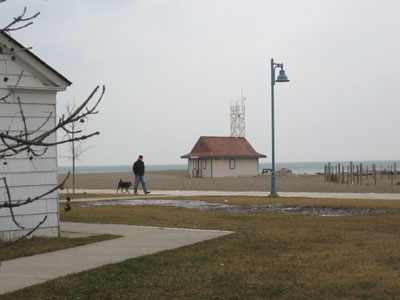
The Beach - a dog lover's paradise
On this cold and windy winter day, Gene took his big bundle of
keys and opened the seniors' room next to the club house of the
Beaches Lawn Bowling Club so we would be able to continue our conversation
sheltered from the icy breeze. Once inside, Gene showed me a variety
of oversize photo boards that illustrate the history of the Beach.
He explained that the original Bell Telephone Exchange for the Beach
neighbourhood is located at the north east corner of Queen and Lee,
and years ago was converted into a residential apartment building.
After showing me various historic views of the area he also mentioned
the Victoria Park Forest School that was dedicated to sickly children
to help them regain their health. The Forest School was closed in
1932 due to the construction of the R.C. Harris Water Filtration
Plant.
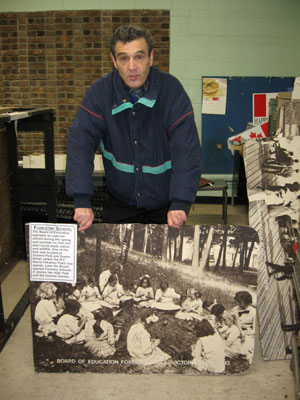
Gene shows a photo of the Victoria Park Forest School
As we were talking all of a sudden the doors of the building opened,
and we had an unexpected visitor. Angela Miller, a foreperson for
the Toronto Parks and Recreation Department had entered to see what
was going on, and this was a perfect opportunity to find out more
about the City’s role in the upkeep of the Beach. Angela explained
that her unit is responsible for maintenance, garbage pickup and
special events in the area which spans about 80 acres. In the summer
she runs a crew of 14 full-time workers while in the winter Angela
and her colleague Laurie are the only ones permanently entrusted
with the maintenance of the public parks in this area. Laurie went
on to say that the area requires a lot of upkeep due to the frequent
special events that are being held here. Virtually every weekend
there is a permit for a special event, and big events like the Beaches
Jazz Festival require a lot of setup in advance and extensive
cleanups on a daily basis.
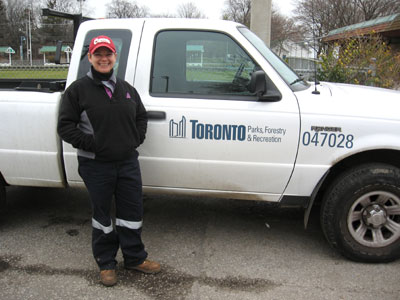
Angela Miller who looks after maintenance in the Beach
The logistics of public events are sometimes underestimated, and
especially in a popular and busy area like the Beach, seemingly
simple questions of maintenance and garbage removal are of critical
importance to residents and visitors alike. Gene and I headed back
out into the cold and we briefly stopped off at the skating rink
that was busy with a group of hockey fanatics. In the summer this
facility is used for roller hockey and lacrosse.
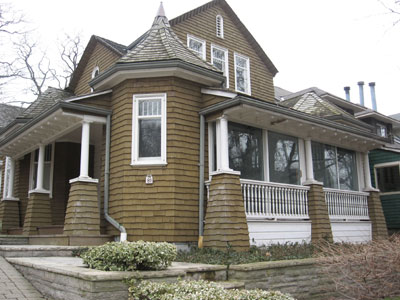
Inglenook, a historic residence
We then walked up Waverley Road, and Gene pointed out one of the
many historic homes in the Beaches: a residential property called
Inglenook, which was originally the Charles Frederick Wagner House,
built around 1900 and saved from demolition by a local petition.
Just a few steps away is the John Wright House, constructed just
3 years later in the popular Queen Anne Revival style as one of
the first mixed-use residential-commercial properties on Queen Street
East. Today the building features a storefront that hides the original
north façade.
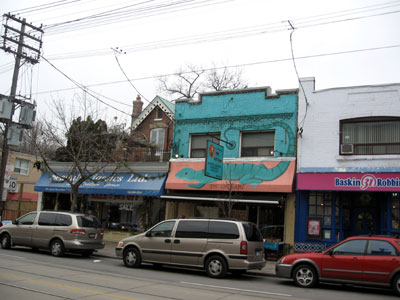
Queen Street East: houses are set back behind storefronts
Gene pointed out that houses were originally set back from Queen
Street and the front lawns were later filled in with commercial
storefronts. We continued our walk westwards on Queen Street and
entered the Beaches Mall, a large building that used to be called
the Allen Theatre, one of several historic theatres in the Beach,
all of which are still standing and most of which have been refunctioned.
Only the Fox Theatre, Toronto’s longest continuously running
movie theatre, is still used for its original purpose.
A few steps further west at the intersection of Kippendavie Avenue
and Queen Street is a beautiful historic building that today holds
one of my favourite restaurants in the Beach: Nevada’s. This
is the former Home Bank of Toronto building, a financial institution
created by famous Toronto entrepreneur Henry
Pellatt, builder of Casa Loma. The name of the bank can still
faintly be seen under the painted sign on the façade.
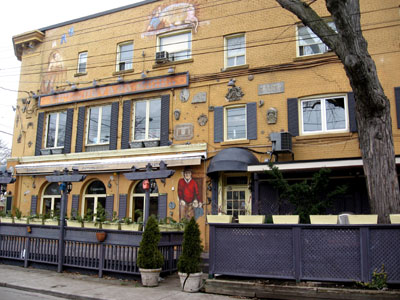
Nevada's Restaurant, the former Home Bank of Toronto
A few steps south on Kenilworth is the former Kenilworth Avenue
Baptist Church that was converted into a synagogue in 1920 and named
the Beach Hebrew Institute. Often
this building is referred to as the Beaches Shul. Sure
enough, Gene had the key and we entered this historic building.
The original church façade was considerably altered to more
closely resemble the architecture of synagogues in small Eastern
European communities. In the early years, during a time when local
residents were not particularly hospitable to Jewish citizens, the
term "synagogue" was intentionally omitted in the name
of this place of worship. Today the Beach Hebrew Institute is a
small welcoming institution without a rabbi whose members lead the
prayers and are very active in the community.
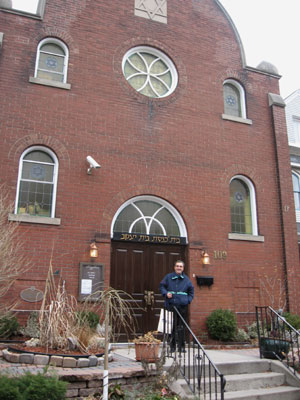
The Beach Hebrew Institute
Just up the street, across from Nevada's
Ristorante, the former Whitelock’s Grocery Store has morphed
into today’s Whitlock Restaurant (which, by the way, features
a delicious brunch), and is one of the few wooden corner buildings
left in Toronto. With a growling stomach and all these wonderful
restaurants around I persuaded Gene to go for lunch, and we headed
into another institution in the Beach: Lick’s, a restaurant
that features a variety of burgers, salads and one of my favourites:
poutine (a popular sloppy yet yummy French-Canadian concoction of
French fries, gravy and cheese curds).
Gene and I headed upstairs and sat down for a chat when he showed
me his home-knitted sweater featuring “Centre
55”, a local community centre that serves the Beach /
East York neighbourhood. Gene regularly helps with their Christmas
activities which feature the “Christmas Hamper” where
more than 900 needy families in the Beach receive a hamper full
of goods including ham or turkey, milk, bread, pasta and toys for
the children. Gene has volunteered for this organization for the
last 25 years.
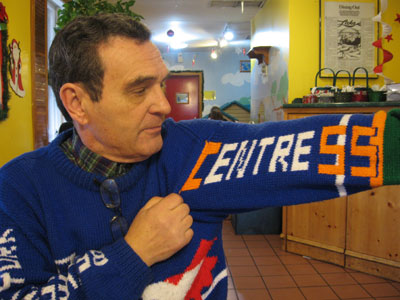
Beach shows off his sweater advertising Community Centre 55
He is also very active with the Toronto Star Santa Claus Fund,
a Christmas initiative that involves volunteers delivering boxes
full of Christmas gifts to needy families. He has been delivering
Star Boxes for about 47 years now in the Parkdale area. Gene Domagala
traces his commitment to charity back to his mother who used to
cook for poor people in this west-end Toronto neighbourhood. Gene’s
parents were Polish immigrants who settled in the Bathurst and Queen
area, and even as a child Gene got exposed to children of all different
backgrounds and nationalities. All the children played together
in this poor neighbourhood. Gene continues this spirit of inclusion
today with his anti-racism work.
His interest in history was stoked early when he played with a
bunch of boys in Toronto’s historic Fort York. Gene attended
a technical high school and by his own admission, Gene realized
early that his future would not lie in the trades. His favourite
person in high school was his social studies teacher who got him
a subscription to TIME Magazine. He also was inspired by the history
teacher and the librarian. Gene’s early interest in history
has resulted in hundreds of articles on local history. In addition,
Gene regularly provides historical walks in the Beach that have
become so popular that they are often attended by dozens of people.
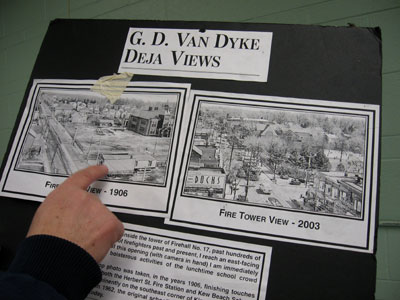
Historic views of Queen Street
After high school Gene worked in a variety of odd jobs, including
a job at the CNE. Several years later he started working at the
Boy’s Club, a non-profit organization operated by the Knights
of Columbus in Little Italy, where he became the program director.
His knack for organization and community work became evident early
in life.
Gene explains that he was supposed to attend a program for social
work at George Brown College but ended up taking a program in architecture
instead and then worked for many years for a Toronto engineering
firm until he was downsized in the early 1990s. Gene’s life
hasn’t been easy, his two twin adult daughters suffer from
Asperger’s syndrome, a neuro-biological developmental disorder,
and over the years Gene has had to become an expert on mental health.
He is also a board member of an organization called “Friends
of the Shopping Bag Lady”, a drop-in centre for women at 416
Dundas Street. During the early part of the 1990s Gene spent some
time in court to fight for custody of his grandchild and now looks
after his granddaughter Siobhon. Since that time Gene has dedicated
himself on a full-time basis to his family and to his extensive
charitable and community work. Gene is not a wealthy man, which
makes his commitment to others even more admirable.
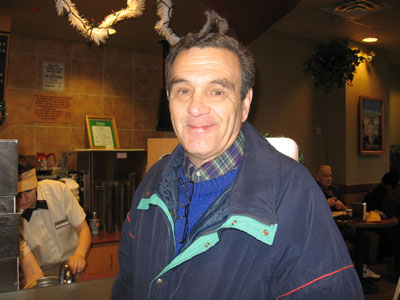
Gene Domagala - an omni-present positive force in the Beach
Gene’s eyes light up when he tells me about his proudest
moment: when he was invited to become a member of the Toronto Historical
Board. He even had a chance to meet the Queen Mother during one
of the organization’s functions. Gene has been actively involved
in a variety of historical preservation projects, including salvaging
the Leuty Lifeguard Station, probably the most well-known landmark
in the Beach. The structure had been ravaged by time and by the
early 1990s it was deemed to be structurally unsound. Gene was one
of the concerned citizens who started talking with the city and
initiated numerous fundraising events to start the restoration of
the Leuty Lifesaving Station.Various special events, music nights,
a volleyball tournament, and sales of t-shirts, buttons and mugs
ended up raising tens of thousands of dollars. Of the total cost
of about $95,000, about 40% came from the community while the City
of Toronto contributed about 60%. Gene is always one of the people
at the forefront of community developments and initiatives.
Gene’s other local involvements include the Spring Sprint,
a fundraiser started 20 years ago by the Beaches Recreation Centre.
He also is one of the volunteers at Slobberfest, a special event
for dog lovers held once a year on a Saturday afternoon in June,
that includes such humorous activities as pet/owner look-a-like
contests, best pet/owner singing duo, best pet howls, best pet trick,
and many other entertaining activities. I even bumped into Gene
myself on New Years Eve when I went skating at the outdoor rink
at Kew Gardens when Gene came by to announce free hot chocolate
and marsh mallows for the New Years Eve Party at the skating rink.
Gene undoubtedly is an omni-present and well-treasured pillar of
this community.
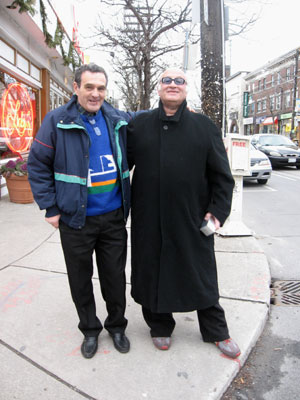
Gene with Zoltzz (entrepreneur Harold Weisfeld)
Our lunch at Lick’s had been the perfect time to get to know
Gene a little better before we headed off and continued our walk
west on Queen Street. Back on the street we ran into a colourful
local personality: Harold Weisfeld, a.k.a. “Zoltzz”,
owner of “Ends Designerwear Boutique”, a famous designer
label discount store near Queen Street and Elmer Avenue, a place
where I personally have found many a bargain over the years. We
headed further west and Gene pointed out the former Bank of Toronto
Building, which today houses the “Lion on the Beach”,
a popular local pub. Just a few steps further west we briefly went
into “Morguet”, a jewellery shop that offers hand-crafted
jewellery, custom gold and silver smithing, where we said hello
to the owner Sergio who had come to Toronto years ago from Latin
America.
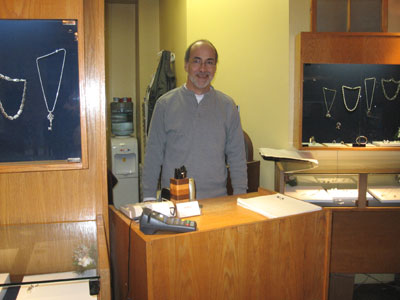
Sergio from the Morguet jewellery shop flashes a friendly smile
Just across the street, Gene pointed out a convenience store that
used to be the childhood home of world renowned director Norman
Jewison, one of the prominent (former) residents of the Beach. We
then admired the Kew Beach Firehall
No. 17, a historic masonry building in the Queen Anne architectural
style dating back to 1905 / 1906.
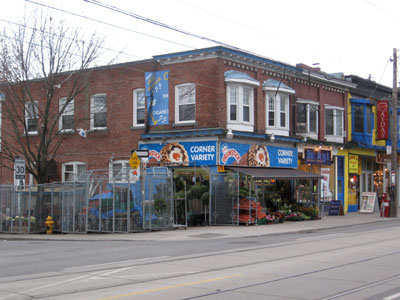
Norman Jewison's childhood home
We continued on and turned south at the corner of Woodbine and
Queen where Gene showed me what he refers to as the “Psychedelic
House”, a brightly painted Victorian house with interesting
ornaments. On our way back towards the Beaches Library Gene explained
that several churches and the local synagogue
offer drop-in services for the homeless. This program is offered
at a different location every weekday and gives street people a
chance to come in from the cold.
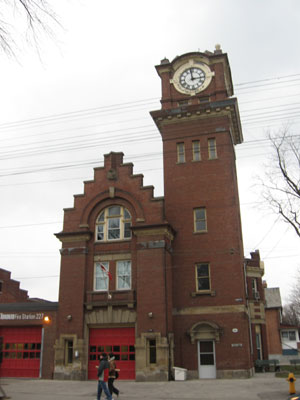
The historic Kew Beach Fire Hall No. 17
Our official tour had concluded and Gene dropped me off at the
Beaches Library, where I thanked
him for his time and all the interesting stories he had shared with
me. He left me with Barbara Weissman, the librarian who helped me
put together books and articles about the Beach.
It was only after reading these articles that I realized that
Gene has been the recipient of the first “Citizen of the Year”
award, given out by Community Centre 55.
Not surprisingly, Gene in his modesty had not even mentioned this
important fact. In 2001, a stone was unveiled in the “Walk
of Fame” located in the Millenium Gardens at Coxwell and Eastern
Avenues, commemorating Gene and the various other Citizens of the
Year that have followed into his footsteps since then. A major article
in the Toronto Star featured Gene’s accomplishments and his
dedication to others and referred to Gene Domagala as a “human
convenience store for people with problems” in the words of
Glenn Cochrane, another prominent
resident of the Beach.
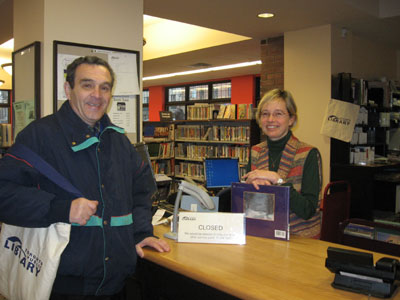
Gene with Barbara Weissman from the Beaches Library
It was a real privilege meeting Gene Domagala and spending some
time with him getting to know his neighbourhood and his way of thinking.
The dozens of people whose faces lit up when they greeted him during
our walk attest to the fact that Gene is one of the true heroes
of the Beach.
Related Articles:
Celebrate Toronto
- An article series to celebrate my chosen home town
Gene Domagala - A human convenience
store of charity and community involvement in Toronto's Beach
Arie Nerman & the Beach Hebrew Institute:
The People's Synagogue
Vivetha Bistro: A popular spot
with eclectic food
Glenn Cochrane - Media
personality, author and expert fundraiser – a champion of
the Beach for almost 40 years
Michelle Gebhart: A
true Renaissance woman: from army brat to expert renovator, biker
lady, successful restaurateur & dedicated youth volunteer
Michael Prue: A working class success
story - from Regent Park to Queens Park
Alex Winch & the
Beach Solar Laundromat – Unstoppable when it comes to championing
renewable energy & innovative entrepreneurship
Mary Lee: A restaurant owner with a heart
for the arts
Marie Perrotta from the Pegasus
Community Project reaches for the stars
Burgie and Benedetta from the Konditor
coffeehouse create Austrian delicacies in Toronto's Beach
Bob Murdoch from Community Centre
55 - 25 years of community service in the Beach
Steve and Paul from Accommodating
the Soul B&B: hospitality with a personal touch
John Dowding: A private lesson in
photography from a true master
Lucille Crighton: A textile
arts Hall of Famer in Toronto's Beach
Lido Chilelli: Founder
of the Toronto International Beaches Jazz Festival
Fire Station 227: History, heroism
and local connections in the Beach
The Green Eggplant: Healthy Mediterranean
food and big solid portions
The Balmy Beach Club - Legend
by the Lake & Toronto's best-kept secret
The Garden Gate Restaurant a.k.a. "The
Goof" - Good food in the Beach since 1952
Ralph Noble: Firefighter,
lifesaver and creator of the most famous mural in the Beach –
a noble man indeed
Sandra Bussin
- City Councillor and Deputy Mayor shows me her neighbourhood
The Toronto Beach Rotary Club:
Service above Self and the joys of volunteering
The Beaches Lions
Club: Charity and community projects in the Beach since 1935
The Beach Business
Improvement Area: A general overview of the Beach and the merchants
and activities on Queen Street East
Maria Minna:
An Italian-Canadian immigrant story and a life-long fight for social
justice
The Beach Metro Community
News: Much more than just the news
The Kingston Road Business Community:
A neighbourhood undergoing revitalization and an integral part of
the Beach
Andrew Smith and Rachel Howard:
Creative entrepreneurs and dedicated community builders
Nevada's Ristorante: Where
hospitality is a family affair
Maria Minna: Another neighbourhood
walk and talk and discoveries along Queen Street East
St. Aidan's Church:The spirit of charity
in the Beach comes full circle
Gene Domagala takes me on a history
tour of the eastern and northern part of the Beach - a perfect day
of discovery
The Beaches Library: A centre
of learning for all ages
A walk along Kingston Road:
A shopping district definitely worth a visit
55 Division: Serving and protecting
- community policing in action
|